Blount Island Command is a marine corps support facility located in Jacksonville, Florida.
Blount Island Command is a marine corps support facility located in Jacksonville, Florida.
In 1977, President Jimmy Carter signed the directive that created the Rapid Deployment Joint Task Force. By 1980, the Marine Corps had seven Military Sealift Command chartered vessels that could carry supplies where needed. These dedicated ships were loaded in Wilmington, North Carolina in July 1980 and became fully operational in 1981. Equipment and ship maintenance for them was conducted in Okinawa and Subic Bay Naval Base in the Philippines.
That same year, planning began for a permanent support force. 13 ships were organized into three squadrons and strategically located to support global coverage. The new program became operational between 1984 and 1986.
Maritime Prepositioning Ships Squadron-1 (MPSRON-1) became operational in 1984 on the U.S. East Coast, supporting the 6th Marine Amphibious Brigade (MAB) (all MABs changed to MEBs in the late 1980s), and was relocated following Operation Desert Storm to the Mediterranean Sea to establish a forward presence in the European theater. MPSRON-2 replaced the NTPF ships in the Indian Ocean (Diego Garcia) in 1985 and continued to support 7th MAB based at Camp Pendleton, California. The first two squadrons were loaded at Wilmington, North Carolina (1984-85). MPSRON-3 was established in the Pacific Ocean (Guam and Tinian) in 1986 supporting 1st MAB based in Hawaii. The third squadron was loaded at Panama City, Florida (1986). The ammunition for all three squadrons was loaded at the Military Ocean Terminal, Sunny Point, North Carolina.

Operation Desert Shield/Desert Storm validated the MPF concept when the MPF supported the establishment of the first self-sustaining, operationally capable force in northern Saudi Arabia. The first battalion of the 7th MEB occupied its defensive positions within four days of the MPS arrival. The first nine MPF ships from MPSRON-2 and MPSRON-3 offloaded in August 1990 and provided equipment and 30 days sustainment for two-thirds of the Marine Corps forces ashore, as well as supporting United States Army forces. The ships of MPSRON-1 offloaded in December 1990.
In June 1991, MPF assets were employed as part of Operation Fiery Vigil to assist the Republic of the Philippines when Mount Pinatubo erupted, burying whole cities and forcing the evacuation of Clark Air Base. Also, from December 1992 through May 1993, four MPS, reconstituted in Al Jubayl, supported Marines conducting peacekeeping and humanitarian assistance operations in Somalia during Operation Restore Hope (ORH). In January 2003, 11 of the then 15 MPF ships were offloaded in support of Operation Iraqi Freedom (OIF) and reconstituted between July and November 2003. In February 2004, selected equipment and supplies from MPSRON-2 were used in support of OIF-II.
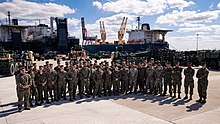
The key to successful employment of a Marine Air Ground Task Force (MAGTF) that falls in on the Maritime Prepositioning Ships (MPS) Program or Marine Corps Prepositioning Program – Norway (MCPP-N) equipment is the availability and readiness of the prepositioned equipment and supplies. BICmd works closely with the supported expeditionary force commander to exceed ISO 9001 goals of 98% attainment, 98% readiness, and 98% data accuracy of the prepositioned combat capability sets. BICmd's focus will always be on the combat readiness, visibility, and attainment of prepositioned equipment and supplies.[ citation needed ]
In 1986, the Marine Corps established the Biennial Maintenance Command (BMC) at Blount Island, Jacksonville, Florida on 262 acres (1.06 km2) leased from Gate Maritime Properties (GMP) for $11M per year. In 1989, Blount Island Command was established as a subordinate command to Marine Corps Logistics Base Albany, Georgia.

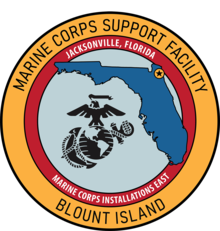
The lease between GMP and the Marine Corps was due to end in 2004, and in 2000, the Corps stated their intentions to purchase the property when the lease expired. The Marine Corps budget included $115.7 million for the acquisition, but extended negotiations did not result in an agreement. GMP contended that the land was worth between $160 million and $200 million, so in August 2004, the Marine Corps seized 1,100 acres (4.5 km2) on Blount Island (GMP's entire Blount Island holdings) by eminent domain and initially paid $101 million. When land is seized by eminent domain for uses that benefit the public, the government is required to pay landowners "just compensation", so GMP asked for a jury to decide the land's value. On November 14, 2005, a jury determined that the government must pay $160 million for the parcel. [1] MCSF-BI was officially activated as the host installation command for BICmd on 21 November 2006. The installation is a subordinate command of the Marine Corps Installations East, which is located at Camp Lejeune, North Carolina.
Blount Island Command is now operationally under the command of the Marine Corps Logistics Command (MARCORLOGCOM). MARCORLOGCOM is located at Marine Corps Logistics Base in Albany, Georgia. BICmd manages Marine Corps Contractor Logistics Support (CLS) programs.
BICmd's functional responsibilities for military forces include:
Blount Island Command's location offers a number of strategic advantages such as:

Approximately once every 42 months, the MSC Maritime Prepositioning Ships (MPS) must go into dry dock for inspection and maintenance. The Marine Corps uses this time to access the ships' equipment which is then inspected, maintained, and then tested. Combat equipment for the ship are also repaired and painted as required. Vehicle and equipment modifications and upgrades are installed (or replaced) during this time. BICmd's government workforce of approximately 250 military and civilian employees (GS). Work with roughly 1,000 civilian contractors (CTR) to produce high quality, reliable combat capability sets for operational use by the Fleet Marine Force (FMF).
Marine Corps Support Facility Blount Island (MCSF-BI) is among the latest US bases built. It was built for maintenance operations to the maritime ships.

The base is responsible for the planning, coordination and execution of logistics procedures of the MPF. The ships are used in various operations. They are loaded and sent to the ocean, where they wait for their destination. Each operation may have a military or a humanitarian purpose. All this work is handled by over 1000 civilians, led by 250 military troops. Once an operation is complete, the ship gets back to the base, is loaded again and heads back to the ocean for new orders. It is a continuous cycle.
Blount Island Command (BICmd) provides technical assistance to Marine Air-Ground Task Force (MAGTF) commanders for all aspects of planning, deployment, arrival and assembly, and reconstitution of prepositioned assets. Directly supporting power projection during global crises.

Located in Jacksonville, Florida, aboard Marine Corps Support Facility Blount Island (MCSF-BI), this industrial base and a robust local Navy support infrastructure provides an advantage not readily available to other sites. The MPF consists of two Maritime Prepositioning Ship Squadrons that carry the combat equipment and sustainment to support up to two Marine Expeditionary Brigades of roughly 18,000 Marines and Sailors each. BICmd also manages the Marine Corps Prepositioning Program-Norway and is involved with ongoing efforts to develop a Global Positioning Network.


A Marine expeditionary unit is the smallest air-ground task force (MAGTF) in the United States Fleet Marine Force. Each MEU is an expeditionary rapid reaction force ready to answer any crisis, whether it be disaster aid or a combat mission. Marine amphibious unit (MAU) was the name used until the late 1980s.

USNS Sacagawea (T-AKE-2), a Lewis and Clark-class dry cargo ship, is the third ship operated by the United States Navy to be named for Sacagawea, the Shoshone woman who acted as guide and interpreter for the Lewis and Clark Expedition, and one of the few United States Navy ships named for women.

Marine Corps Logistics Base Albany is a United States Marine Corps base located just outside Albany, Georgia. The primary mission of the units on the base is to rebuild and repair ground combat and combat support equipment and to support installations on the East Coast of the United States. Today one of MCLB Albany's most important facilities is the Marine Corps Logistics Command's Maintenance Center. The only other facility of this kind is located at MCLB Albany's sister installation, Marine Corps Logistics Base Barstow, California. The base comprises more than 3,300 acres (13 km2) and in 2002 employed more than 2,400 civilians along with a complement of 600 Marines. One of the Corps' major commands, Marine Corps Logistics Command, is based at MCLB Albany. The command also encompasses activities at bases in Barstow, California, and Jacksonville, Florida.
Combat service support is a topic that is, broadly speaking, a subset of military logistics. However, combat service support is often more limited in depth, as the related groups primarily address factors supporting readiness for combat operations. The United States Department of Defense organizes various agencies providing services such as medical assistance, for example, akin to other nations' militaries.

The II Marine Expeditionary Force is a Marine Air-Ground Task Force consisting of ground, air and logistics forces capable of projecting offensive combat power ashore while sustaining itself in combat without external assistance for a period of 60 days. The II Marine Expeditionary Force is commanded by a lieutenant general, who serves under U.S. Marine Corps Forces Command, providing Marine fighting formations and units to European Command, Central Command and Southern Command. The current Commanding General is Lieutenant General David A. Ottignon. The Deputy Commanding General is Brigadier General Andrew T. Priddy and the Senior Enlisted Leader is Sergeant Major David A. Wilson.
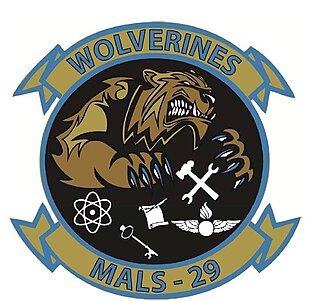
Marine Aviation Logistics Squadron 29 (MALS-29) was an aviation logistics support unit of the United States Marine Corps. Known as the "Wolverines", they fell under the command of Marine Aircraft Group 29 and the 2nd Marine Aircraft Wing and were based at Marine Corps Air Station New River. MALS 29 supported multiple types of aircraft and provided detachments to aviation combat elements operating globally in support of the United States National Defense Strategy.

The Port of Jacksonville (JAXPORT) is an international trade seaport on the St. Johns River in Jacksonville, Florida. JAXPORT is the largest port by volume in Florida, and the 14th largest container port in the United States. It carries about 18 million short tons of cargo each year and has an annual economic impact of over $31 billion, including 138,500 jobs across the state of Florida related to cargo moving through the port. It handled 1,338,000 containers, and is the second largest handler of vehicles in the United States with 696,500 in 2019.
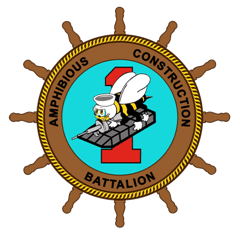
Amphibious Construction Battalion ONE is an amphibious construction battalion in the United States Navy based in Coronado, California, and last in type unit. Amphibious Construction Battalion TWO was its sister unit based in Little Creek, Virginia.
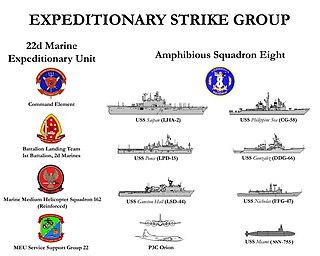
In the United States Navy, the expeditionary strike group (ESG) is a coordinated group of surface ships, aircraft, submarines, and other naval assets. In contrast to carrier strike groups (CSGs), which emphasize air power and are led by a supercarrier, ESGs are strongly suited for amphibious warfare and are led by an amphibious assault ship. The ESG concept was introduced in the early 1990s, based on the Naval Expeditionary Task Force. The U.S. Navy fields nine expeditionary strike groups.
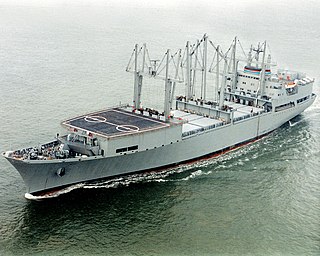
SS Wright (T-AVB-3) is one of two Aviation Logistics Support (Roll-on/Roll-off) Container Ships converted for the United States Navy in 1986, along with sister ship SS Curtiss (T-AVB-4). The ship honors aviation pioneers the Wright brothers.

The Marine Corps Logistics Command (MARCORLOGCOM) is a major command of the United States Marine Corps responsible for providing support for fielded weapons systems, support services and supplies.
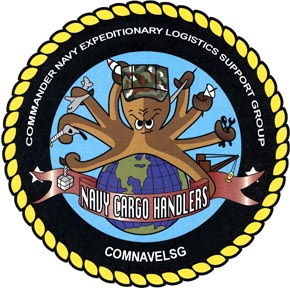
The Navy Expeditionary Logistics Support Group (NAVELSG) is a United States Navy echelon IV component of Navy Expeditionary Combat Command, delivering logistics capabilities with active and mobilization-ready Reserve Force personnel and equipment to theater commanders.

MV Maj. Bernard F. Fisher (T-AK-4396) is a U.S. Military Sealift Command vessel named for US Air Force Medal of Honor recipient Bernard F. Fisher. The vessel is a civilian-owned and operated container ship under contract to deliver pre-positioned supplies and equipment under the Military Sealift Command's Prepositioning Program. The Fisher is one of eight container ships that support Navy, Defense Logistics Agency, Air Force, Marine Corps and US Army operations as part of Maritime Prepositioning Ship Squadron Three.

The Commander, Naval Air Force Atlantic is the aviation Type Commander (TYCOM) for the United States Naval aviation units operating primarily in the Atlantic under United States Fleet Forces Command. Type Commanders are in administrative control (ADCON), and in some cases operational control (OPCON) of certain types of assets assigned to the Pacific and Atlantic Fleets. AIRLANT is responsible for the material readiness, administration, training, and inspection of units/squadrons under their command, and for providing operationally ready air squadrons and aircraft carriers to the fleet.

Blount Island is an island of approximately 2,000 acres (8.1 km2) on the St. Johns River in Jacksonville, Florida, nine nautical miles (16.7 km) west of the Atlantic Ocean. One of three public cargo facilities at the Port of Jacksonville is located there, and it is also the site of the United States Marine Corps Blount Island Command.

Joint Base Charleston is a United States military facility located partly in the City of North Charleston, South Carolina and partly in the City of Goose Creek, South Carolina. The facility is under the jurisdiction of the United States Air Force 628th Air Base Wing, Air Mobility Command (AMC).

Assault Craft Unit ONE, (ACU-1) is a Pacific Ocean Maritime Prepositioning Force in the United States Navy operated under Naval Beach Group ONE out of Naval Amphibious Base (NAB) Coronado with a Forward Detachment in Sasebo, Japan. ACU-1's force consists of Landing Craft Utility (LCU) boats, Landing Craft Mechanized (LCM), Mark 8 boats, and Maritime Prepositioning Force Utility Boats (MPFUBs). The sister unit of ACU-1 is Assault Craft Unit 2 in Naval Amphibious Base Little Creek, Virginia.

Stockpiles of United States Marine Corps weapons, vehicles, ammunition and other equipment have been located in Norway since 1981 as part of what is currently designated the Marine Corps Prepositioning Program-Norway (MCPP-N). This material is stored in a network of climate-controlled caves and buildings near the city of Trondheim, and is drawn upon as part of worldwide US military operations. Norway has met most of the costs of the MCPP-N since the 1990s, and the sites are mainly staffed by Norwegians.

Naval Beach Group One, (NBG-1) is a United States Navy amphibious unit based at Naval Amphibious Base Coronado in Coronado, California. Naval Beach Group Two is its sister unit based at Naval Amphibious Base Little Creek, Virginia.
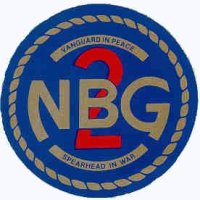
Naval Beach Group Two, (NBG-2) is a United States Navy amphibious unit based at Naval Amphibious Base Little Creek, Virginia Beach, Virginia. Naval Beach Group One is its sister unit based in Naval Amphibious Base Coronado in Coronado, California.